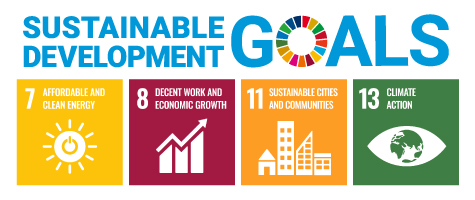Researcher Interviews
Revolutionizing CO2 emissions reduction with Social Digital Twin™! A glimpse into the technologies currently under R&D
JapaneseAgainst the background of multiple converging societal issues such as declining birthrates and aging populations, global warming and economic disparity, it is becoming increasingly complex to make effective policy decisions. To address these challenges, Fujitsu is advancing R&D in Converging Technologies (*1), which combine humanities and social sciences such as behavioral economics with computer science. Among these technologies, Social Digital Twin™ (*2) is one that digitally recreates not only the states of both people and objects, but also economic and social activities, based on real-world data. This is Fujitsu’s unique technology that builds on the concept of digital twin technology, something that has been gaining more and more attention in recent years. Through this Social Digital Twin, we aim to solve increasingly complex and diverse issues. In this article, we interviewed five researchers and engineers from the development team behind the Fujitsu Social Digital Twin Platform (*3), which is now freely accessible for people to use. We asked them to explain the reasons behind for the decision to make the platform public and examples of its application.
Published on August 29, 2024
MEMBERS
-
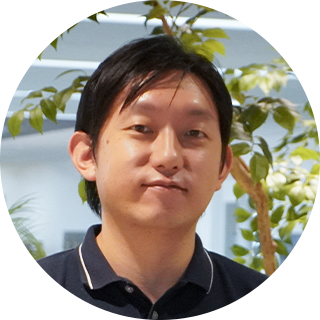
Takanao Sugimoto
Manager
Social Digital Twin Core Project
Converging Technologies Laboratory
Fujitsu Research
Fujitsu Limited -
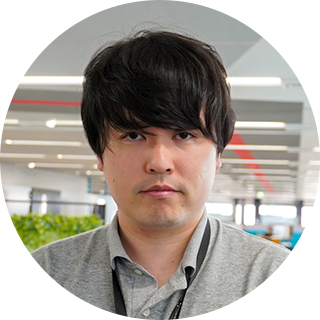
Hirosato Ono
Cloud Architect
Social Digital Twin Core Project
Converging Technologies Laboratory
Fujitsu Research
Fujitsu Limited -
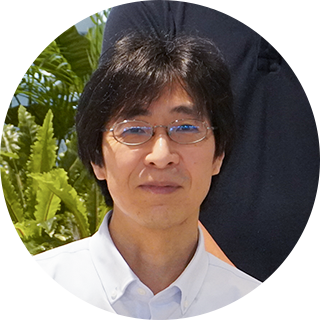
Takashi Ohno
Expert Researcher
Social Digital Twin Core Project
Converging Technologies Laboratory
Fujitsu Research
Fujitsu Limited -
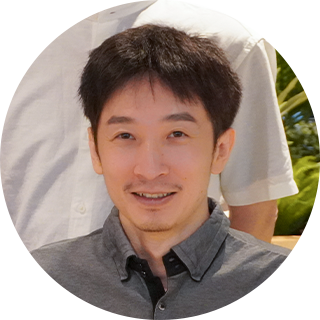
Zhaogong Guo
Researcher
Social Digital Twin Core Project
Converging Technologies Laboratory
Fujitsu Research
Fujitsu Limited -
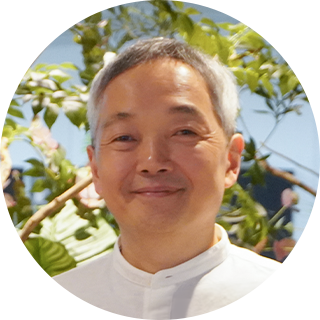
Masahide Noda
Researcher
Social Digital Twin Core Project
Converging Technologies Laboratory
Fujitsu Research
Fujitsu Limited
The Social Digital Twin is the world’s first technology that recreates societal movements in a digital space. It allows the simulation of human and social behavior in a digital space before applying policies to the real world. Fujitsu calls this “Digital Rehearsal™.” When there are many stakeholders, reaching a consensus takes time, and it can be challenging to implement policies as planned. We developed this technology in order to minimize the risks of increased costs and time losses due to failures when implementing policies in the real world. By using Digital Rehearsal to understand the effects and impacts of a policy in advance, the optimal policy can be explored. It is intended for use by municipalities and companies that face various social issues such as CO2 reduction, congestion and traffic jams, urban design, and facility integration and closure, and are making efforts to improve these issues. As a place where this Digital Rehearsal technology can be experienced and verified, the Fujitsu Social Digital Twin Platform has been made publicly available (*4) on the Fujitsu Research Portal, allowing anyone to access the technology easily and engage with it.
Open access to the Fujitsu Social Digital Twin Platform solves complex social issues faster!
What was the motivation behind making the Fujitsu Social Digital Twin Platform public?
Takanao: Our goal is to commercialize the technology we have been researching at an early stage and thereby contribute to solving complex societal issues. For commercialization, it is important to receive feedback from a variety of people, enabling us to improve the technology, and to incorporate new ideas. We have introduced the Social Digital Twin through press releases and academic presentations, continuing to develop the technology while receiving feedback. However, with the Fujitsu Research Portal, anyone can easily access the technology, so we anticipate receiving a broader range of feedback from a larger audience.
Fujitsu Research Portal

When you log in to this portal, you can quickly test Fujitsu’s advanced technology APIs and web applications for free.
You can also try out the Social Digital Twin for free.
Experience the concept of Digital Rehearsal, which is useful for planning social policies related to mobility and disaster recovery plans.
Who are the intended users of the Fujitsu Social Digital Twin Platform?
Takanao: The application areas of the Social Digital Twin are wide-ranging. Specifically, it targets individuals involved in solving societal issues, such as transportation operators, government agency staff, and those engaged in urban consulting. As examples, we have been consulted to assess the impact of a new bridge or building construction on traffic congestion.
Tell us about the features of the Fujitsu Social Digital Twin Platform.
Takashi: To popularize a technology, it's common to define interfaces used by applications, known as APIs, and make them available on a platform to promote usage. However, since the concept of the Social Digital Twin is not yet widely known, just providing APIs makes it difficult to understand. Therefore, we have divided the current offerings into three main categories. First, we have application-based use cases. For example, through specific cases like a demonstration experiment to improve the operation of shared e-scooters (*5) and road pricing, we concretely introduce how the Social Digital Twin can be utilized. This makes it easier to visualize what can be achieved with the Social Digital Twin.
Takanao: Since this approach is limited to specific cases, to avoid the misconception that "Is this all the Social Digital Twin can do?", we have prepared two further categories of offering.
Takashi: The second category adds data customization features to the application-based use cases. For example, in an application for the optimal placement of shared mobility, data customization allows for Digital Rehearsal under different cities and conditions. A manual with instructions is provided, making it easy for first-time users to customize. The third category is aimed at developers. By making APIs available, developers can freely utilize the data and functions underlying the Social Digital Twin to build more complex and advanced applications and systems. Through these three types of offering, we strive to deepen the understanding of the Social Digital Twin for everyone from beginners to developers. Especially for non-technical users, we have made major efforts to make it easier to understand by presenting multiple examples.
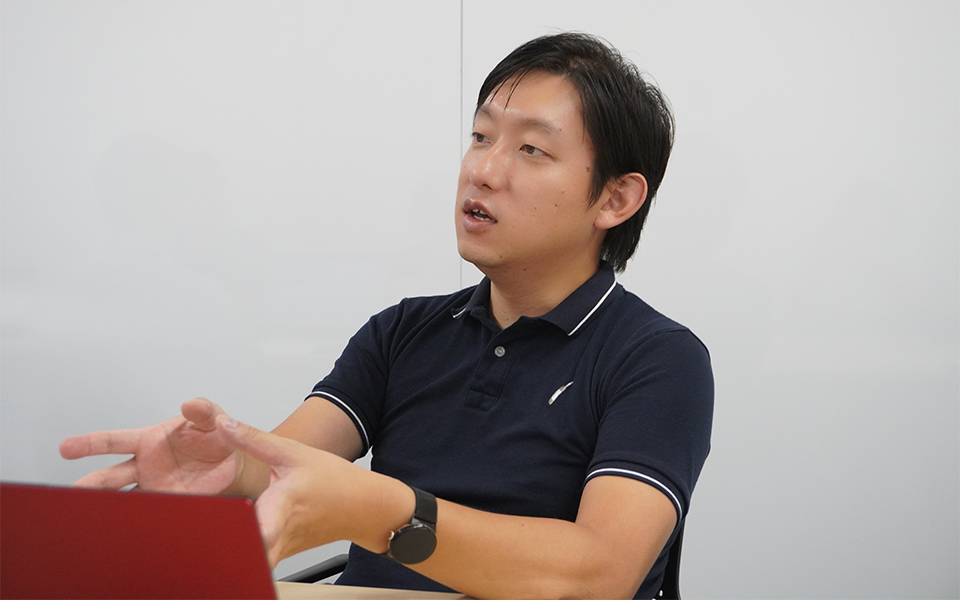

Rationale behind the Fujitsu Social Digital Twin Platform’s fast track launch
What challenges did you face in releasing the platform, and how did you address them?
Hirosato: As Takashi mentioned earlier, one of the challenges was that just using the applications made it difficult to understand the purpose and capabilities of the Social Digital Twin. To address this issue, we created detailed explanations and user manuals to be read before using the applications, helping first-time users grasp the concept and use cases of the Social Digital Twin. Now, we feel that anyone can use this application to perform Digital Rehearsal for transportation mode selection.
Releasing the platform quickly must have been quite challenging. How did you proceed?
Masahide: Making the technology available for anyone to try involves several considerations, such as ensuring security and monitoring usage. By handling these aspects, we allowed the Social Digital Twin development team to focus on their development work. The technologies developed by the Social Digital Twin development team are diverse, and so are the ways they are provided. Sometimes they are provided as applications, other times as APIs. Different approaches for designing and releasing the technology can complicate the process and burden the developers on the Social Digital Twin development team. To simplify this, we asked those developers to provide their technology in a specific format, and based on that, we established rules to ensure security and scalability. By maintaining this unified framework, we were able to build the platform smoothly and release it publicly.
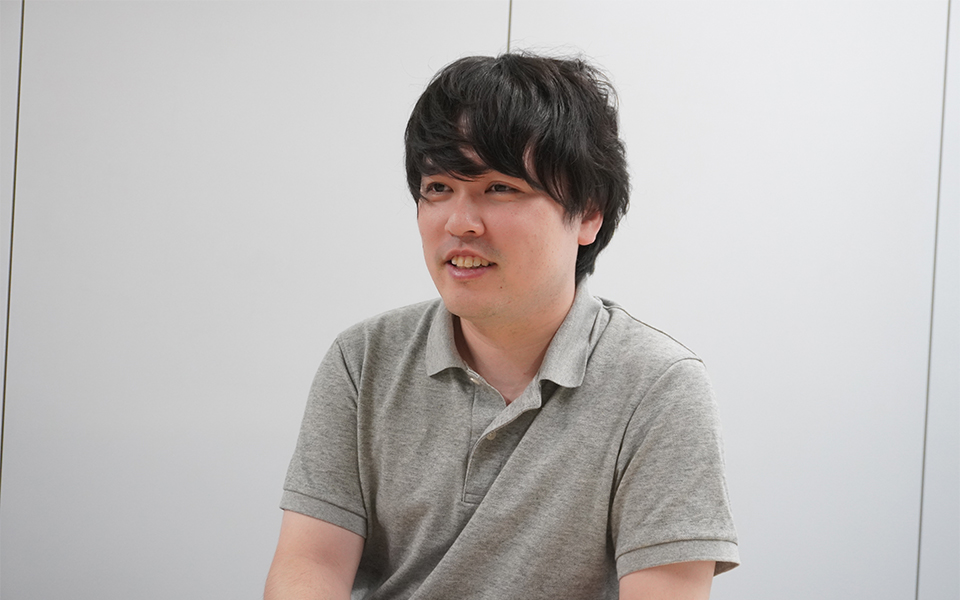
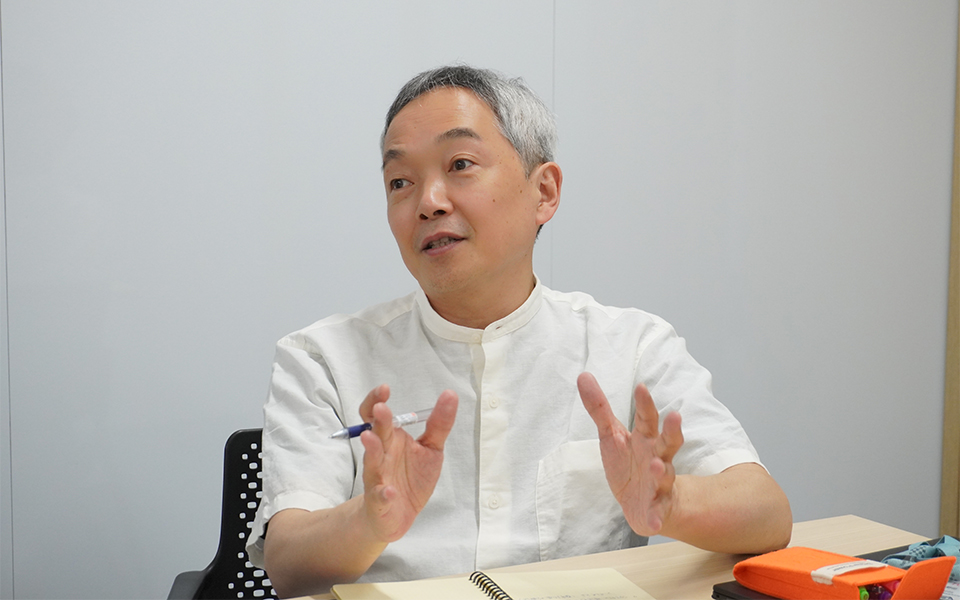
User insights from real-world use cases
What applications or demonstrations are available for the Social Digital Twin?
Zhaogong: Currently, there is one notable demonstration application on the Fujitsu Research Portal - "Optimal Shared Mobility Deployment," which aims simultaneously to reduce urban CO2 emissions and improve transportation convenience. We have also made the data generation tools (*6) available, and we encourage you to try it out. Additionally, we offer "Re-Design Assistance for Public Transportation," which uses the Social Digital Twin for Digital Rehearsal of public transportation design tailored to specific regions, and "Disaster Resilience and Recovery Plans," which supports effective infrastructure recovery planning during disasters. We also provide demonstration videos to help visualize these use cases.
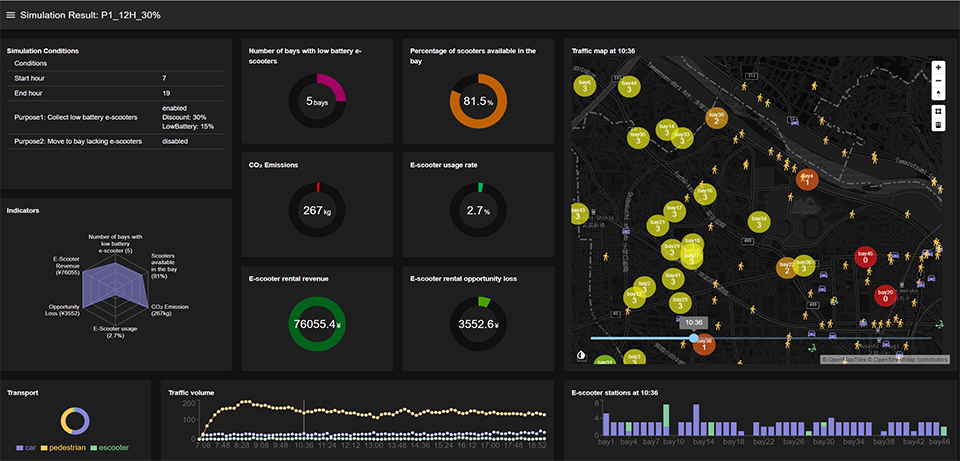 Web app operation interface of Optimal Shared Mobility Deployment application
Web app operation interface of Optimal Shared Mobility Deployment applicationWhat kind of feedback have you received from users?
Takanao: When we introduced the Optimal Shared Mobility Deployment application, along with the data generation tools, to stakeholders in Japan’s bike-sharing industry using overseas examples, we received very positive responses. Additionally, changing the city used in the demonstration to one where the customers actually live made the technology feel more tangible and led to greater empathy with its application.
Zhaogong: We regularly hold internal events where we provide lectures and hands-on experiences of the technology for sales representatives and developers. From these sessions, we receive various feedback on aspects such as website presentation, ease of use, and requests for feature upgrades, which we then incorporate into our updates.
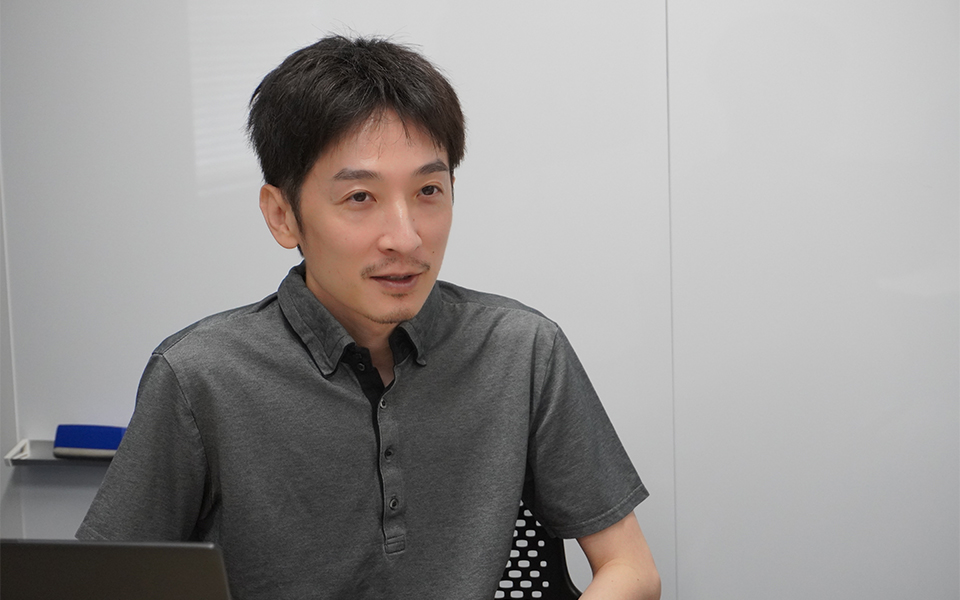 Zhaogong explains how the team developed a data generation tools in response to requests to try Digital Rehearsal in the cities where the customer lives
Zhaogong explains how the team developed a data generation tools in response to requests to try Digital Rehearsal in the cities where the customer livesLooking ahead platform updates and technology dissemination
What are your future intentions for the Social Digital Twin?
Takanao: I believe the Social Digital Twin is a new technology that can lead to solutions for various societal issues. Beyond the examples discussed today, we are continuing to develop the technology through discussions both inside and outside the company on issues such as well-being, disaster prevention, crime prevention, and education. We hope to continue nurturing the technology in collaboration with companies and municipalities working on societal problem-solving, so we encourage everyone to interact with the technology and provide feedback.
Takashi: There is active engagement with Digital Rehearsal in the world today. However, there are still very few concrete examples of successfully applying the optimal measures derived from Digital Rehearsal to real society and demonstrating their effectiveness. For instance, our goal is to conduct demonstrations based on Digital Rehearsal results that show reductions in CO2 emissions and improvements in air quality, and to present tangible outcomes.
Hirosato: I find the concept of the Social Digital Twin very interesting. Creating a twin of the real world, performing Digital Rehearsal within it, and promoting behavioral changes in the real world is a mechanism that I believe will help solve societal issues. Through the release of this platform, we aim to find specific and effective use cases together with our customers. We value these efforts and look forward to creating new value in collaboration with our customers.
Masahide: We continuously introduce and update new technologies on the platform, but recently we have become aware of issues with our feedback collection methods. Even after making the system public, only a small number of people provide feedback, with 1% being a high rate. We believe that using AI chatbots for feedback might be less intimidating than email, and we are exploring new feedback collection methods using this technology. To ensure that the Social Digital Twin becomes widely adopted and used, we want to collect feedback actively and embrace various opinions with a proactive approach.
Zhaogong: I strongly resonate with what everyone has said. Feedback from users is a crucial element in determining the direction of our development. I want to focus on how to leverage user feedback for future development. Speed is especially important, and I intend to actively develop the technology to deliver high-quality results in a short period. I hope everyone will look forward to seeing the evolution of the Social Digital Twin.
-
(*1)
-
(*2)
-
(*3)
-
(*4)
-
(*5)
-
(*6)
Notes (*4)、(*6) only available in Japanese
Fujitsu's Commitment to the Sustainable Development Goals (SDGs)
The Sustainable Development Goals (SDGs) adopted by the United Nations in 2015 represent a set of common goals to be achieved worldwide by 2030. Fujitsu's purpose — “to make the world more sustainable by building trust in society through innovation”—is a promise to contribute to the vision of a better future empowered by the SDGs.
